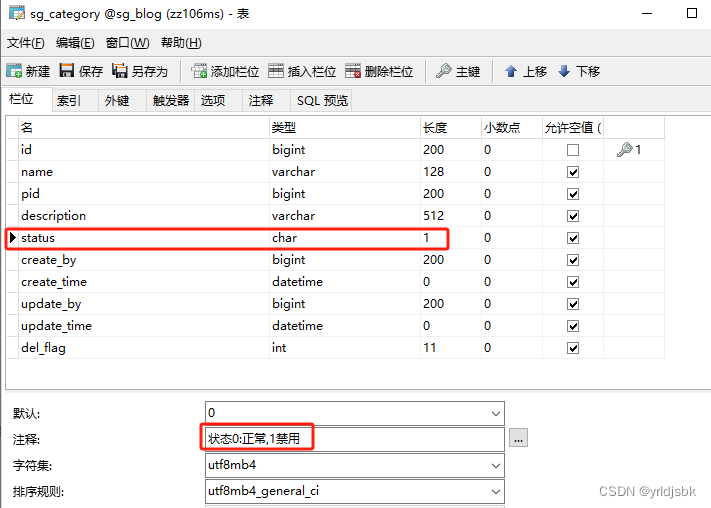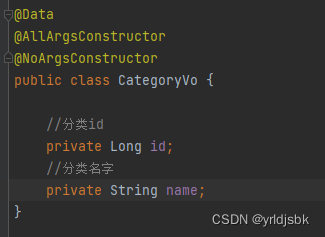-
springboot网站开发0201-使用MybatisPlus查询数据库信息返回前端渲染
springboot网站开发0201-使用MybatisPlus查询数据库信息返回前端渲染!这一次我们将会详细的展示一个完整的数据库查询案例,从查询数据库到返回前端渲染页面完成一个流程。
首先,我们需要清楚,本次业务需求是,查询新闻分类表的内容,把所有新闻分类信息,返回给前端渲染使用。

如图,我们可以看见,前端页面新闻分类列表其实仅需要2个属性值,一个是分类的名字,一个是分类的id.

因此,为了提升客户体验度,我们封装了一个页面模型对象。里面仅仅给他返回2个属性值即可。可以提升前端页面渲染的速度,减轻客户手机的cpu压力。
接下来,我们就需要考虑一件事,我们到底是需要什么样的新闻分类列表曝光给前端看见。
比如:业务场景之一(我们只需要把当前已经有发布过新闻稿件的分类列表信息,给前端客户看见。尚未发布过新闻稿件的分类列表,无需给前端看见。)
如果是这样子,那就需要前提去查询一下,当前新闻表(sg_airticle)里面新闻稿件状态为正常的所属分类id了。然后做一个汇总,就可以拿到当前有新闻稿件的分类id集合了。
然后再根据这个分类id集合去查询新闻分类标题(sg_category)里面的详情信息。获取具体的分类属性值信息。
*********---------------*********
场景模拟之二:如果我们不关心当前新闻分类下面是否有没有新闻稿件,那就简单多了,直接干脆一点,直接查询分类表信息,返回就行了。省去前面查询新闻表的步骤了。
经过以上分析,我们本次为大家展示的是场景模拟之一的情况。先去查询新闻表里状态为正常的新闻稿件,获取他们的分类id。
- package com.blog.service.impl;
- import com.baomidou.mybatisplus.core.conditions.query.LambdaQueryWrapper;
- import com.baomidou.mybatisplus.extension.service.impl.ServiceImpl;
- import com.blog.constants.SystemConstants;
- import com.blog.domain.ResponseResult;
- import com.blog.domain.entity.Article;
- import com.blog.domain.entity.Category;
- import com.blog.domain.vo.CategoryVo;
- import com.blog.mapper.CategoryMapper;
- import com.blog.service.ArticleService;
- import com.blog.service.CategoryService;
- import com.blog.utils.BeanCopyUtils;
- import org.springframework.beans.factory.annotation.Autowired;
- import org.springframework.stereotype.Service;
- import java.util.List;
- import java.util.Set;
- import java.util.function.Function;
- import java.util.stream.Collectors;
- /**
- * 分类表(Category)表服务实现类
- *
- * @author makejava
- * @since 2023-08-21 14:27:46
- */
- @Service("categoryService")
- public class CategoryServiceImpl extends ServiceImpl<CategoryMapper, Category> implements CategoryService {
- @Autowired
- private ArticleService articleService;
- @Override
- public ResponseResult getCategoryList() {
- //查询文章表,状态为已发布
- LambdaQueryWrapper<Article> articleWrapper = new LambdaQueryWrapper<>();
- articleWrapper.eq(Article::getStatus, SystemConstants.ARTICEL_STATUS_NORMAL);
- List<Article> articleList = articleService.list(articleWrapper);
- //获取文章分类id,并且去重
- Set<Long> categoryIds = articleList.stream()
- .map(Article::getCategoryId)
- .collect(Collectors.toSet());
- //查询分类表,
- List<Category> categories = listByIds(categoryIds);
- categories = categories.stream()
- .filter(category -> SystemConstants.STATUS_NORMAL.equals(category.getStatus())).collect(Collectors.toList());
- //封装vo-前端页面需要的实体类集合,只需要极少数的属性值即可因此要做个提取封装
- List<CategoryVo> categoryVos = BeanCopyUtils.copyBeanList(categories, CategoryVo.class);
- return ResponseResult.okResult(categoryVos);
- }
- }
如图代码,我们第一步,就是去查询文章表,状态为已发布(正常显示)的新闻集合,
List<Article> articleList = articleService.list(articleWrapper);得到了一个新闻的集合对象,
- //获取文章分类id,并且去重
- Set<Long> categoryIds = articleList.stream()
- .map(Article::getCategoryId)
- .collect(Collectors.toSet());
这一步就是提取分类id信息的操作。使用了流操作。回头单独会讲一下流操作的内容。
返回了一个Set集合,不允许有重复的情况,Set集合里面的元素属性是,不可以重复,且无序。
- //查询分类表,
- List<Category> categories = listByIds(categoryIds);
- categories = categories.stream()
- .filter(category -> SystemConstants.STATUS_NORMAL.equals(category.getStatus())).collect(Collectors.toList());
如图代码,我们使用了mybatisPlus插件自带的方法,listByIds
default java.util.List<T> listByIds(java.util.Collection<? extends java.io.Serializable> idList)如图,插件告诉我们,这个方法返回了还是一个list集合,它的参数类型是一个集合。
随后,我们做了一个数据过滤,只提取出来了状态为正常的分类信息。()


数据表内状态码数据类型是char(单字符),对应到java类型是String。
- //封装vo-前端页面需要的实体类集合,只需要极少数的属性值即可因此要做个提取封装
- List<CategoryVo> categoryVos = BeanCopyUtils.copyBeanList(categories, CategoryVo.class);
最后,再次封装提取成前端页面需要使用的页面模型对象。就使用到了我们之前自定义的一个工具类。
有了持久层和业务层的协助,我们就可以看前端控制器的代码了。
- package com.blog.controller;
- import com.blog.domain.ResponseResult;
- import com.blog.service.CategoryService;
- import org.springframework.beans.factory.annotation.Autowired;
- import org.springframework.web.bind.annotation.GetMapping;
- import org.springframework.web.bind.annotation.RequestMapping;
- import org.springframework.web.bind.annotation.RestController;
- @RestController
- @RequestMapping("/category")
- public class CategoryController {
- @Autowired
- private CategoryService categoryService;
- @GetMapping("/getCategoryList")
- public ResponseResult getCategoryList(){
- return categoryService.getCategoryList();
- }
- }
控制器代码非常简单。只需要设置好请求的业务路径,调用业务层实现类的方法,直接返回对象即可。前端会从对象中提取它们想要的数据。

为了统一规范,我们前端返回数据统一都是有这个工具类,封装起来。方便协调。
下一个小节,我们给大家展示一下,前端VUE里面的代码情况。
-
相关阅读:
【Unity3D】获取UGUI位置不正确问题
向量与矩阵范数、分布函数、 矩阵分解、随机抽样
golang chan传递数据的性能开销
什么是Jmeter ?Jmeter使用的原理步骤是什么?
低代码助力中小企业数字化
Composer更新所有依赖包
代码随想录刷题|LeetCode 70. 爬楼梯(进阶) 322. 零钱兑换 279.完全平方数
后端不提供文件流接口,前台js使用a标签实现当前表格数据(数组非blob数据)下载成Excel
AWS Cloudformation入门项目实践
函数入门及C Primer Plus第五章编程题
- 原文地址:https://blog.csdn.net/yrldjsbk/article/details/136257710
